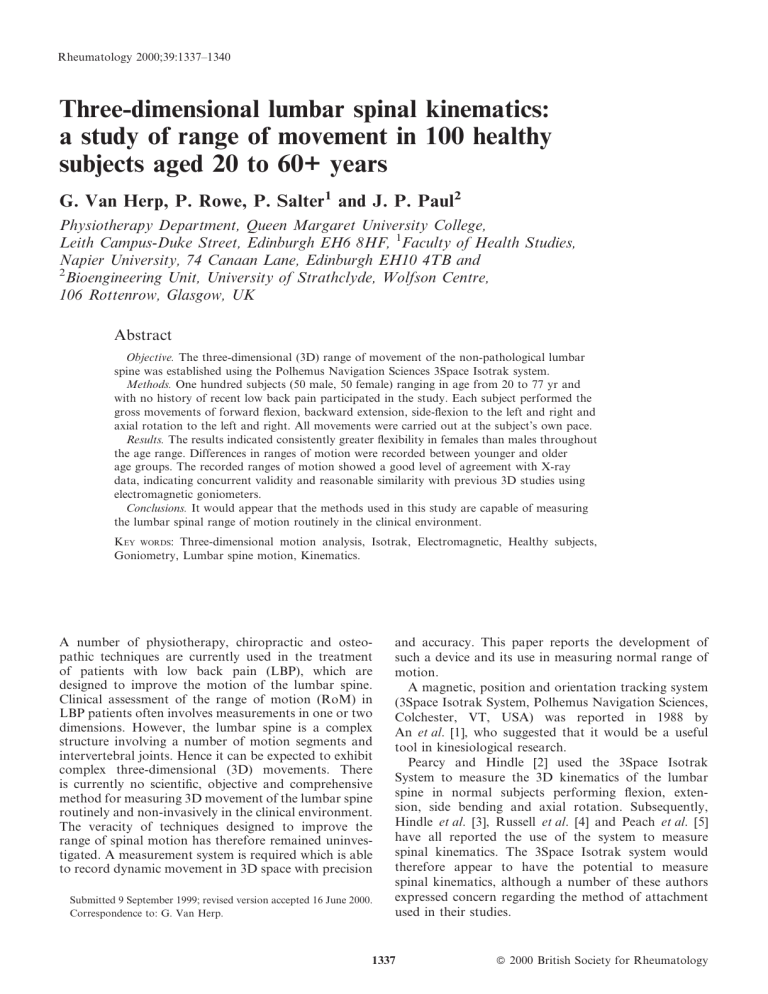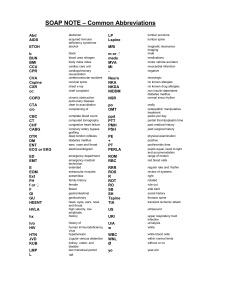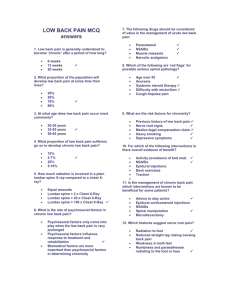
Rheumatology 2000;39:1337±1340 Three-dimensional lumbar spinal kinematics: a study of range of movement in 100 healthy subjects aged 20 to 60+ years G. Van Herp, P. Rowe, P. Salter1 and J. P. Paul2 Physiotherapy Department, Queen Margaret University College, Leith Campus-Duke Street, Edinburgh EH6 8HF, 1Faculty of Health Studies, Napier University, 74 Canaan Lane, Edinburgh EH10 4TB and 2 Bioengineering Unit, University of Strathclyde, Wolfson Centre, 106 Rottenrow, Glasgow, UK Abstract Objective. The three-dimensional (3D) range of movement of the non-pathological lumbar spine was established using the Polhemus Navigation Sciences 3Space Isotrak system. Methods. One hundred subjects (50 male, 50 female) ranging in age from 20 to 77 yr and with no history of recent low back pain participated in the study. Each subject performed the gross movements of forward ¯exion, backward extension, side-¯exion to the left and right and axial rotation to the left and right. All movements were carried out at the subject's own pace. Results. The results indicated consistently greater ¯exibility in females than males throughout the age range. Differences in ranges of motion were recorded between younger and older age groups. The recorded ranges of motion showed a good level of agreement with X-ray data, indicating concurrent validity and reasonable similarity with previous 3D studies using electromagnetic goniometers. Conclusions. It would appear that the methods used in this study are capable of measuring the lumbar spinal range of motion routinely in the clinical environment. KEY WORDS: Three-dimensional motion analysis, Isotrak, Electromagnetic, Healthy subjects, Goniometry, Lumbar spine motion, Kinematics. A number of physiotherapy, chiropractic and osteopathic techniques are currently used in the treatment of patients with low back pain (LBP), which are designed to improve the motion of the lumbar spine. Clinical assessment of the range of motion (RoM) in LBP patients often involves measurements in one or two dimensions. However, the lumbar spine is a complex structure involving a number of motion segments and intervertebral joints. Hence it can be expected to exhibit complex three-dimensional (3D) movements. There is currently no scienti®c, objective and comprehensive method for measuring 3D movement of the lumbar spine routinely and non-invasively in the clinical environment. The veracity of techniques designed to improve the range of spinal motion has therefore remained uninvestigated. A measurement system is required which is able to record dynamic movement in 3D space with precision Submitted 9 September 1999; revised version accepted 16 June 2000. Correspondence to: G. Van Herp. and accuracy. This paper reports the development of such a device and its use in measuring normal range of motion. A magnetic, position and orientation tracking system (3Space Isotrak System, Polhemus Navigation Sciences, Colchester, VT, USA) was reported in 1988 by An et al. w1x, who suggested that it would be a useful tool in kinesiological research. Pearcy and Hindle w2x used the 3Space Isotrak System to measure the 3D kinematics of the lumbar spine in normal subjects performing ¯exion, extension, side bending and axial rotation. Subsequently, Hindle et al. w3x, Russell et al. w4x and Peach et al. w5x have all reported the use of the system to measure spinal kinematics. The 3Space Isotrak system would therefore appear to have the potential to measure spinal kinematics, although a number of these authors expressed concern regarding the method of attachment used in their studies. 1337 ß 2000 British Society for Rheumatology 1338 G. Van Herp et al. Methods Aims This study describes the collection of data from 100 healthy subjects in ®ve age cohorts. The purpose of this study was 2-fold: (i) to evaluate the 3Space Isotrak system objectively for its ability to record ranges of movement in a diverse population when attached by a new method; and (ii) to provide data on the normal 3D range of motion using six gross movements, viz. forward ¯exion, extension, lateral bending to the right, lateral bending to the left, axial rotation to the right and axial rotation to the left. The 3Space Isotrak tracking system uses a source module generating a low-frequency magnetic ®eld and a sensor containing three orthogonal coils to determine the position and orientation of the sensor relative to the source in three dimensions. The device was attached to the dorsal surface of the back so as to measure lumbar spinal motion between S1 and T12. The source was attached to the pelvis at the level of S1 with the cable downwards. The sensor was attached over the spinous process of T12 with the cable upwards. These bony landmarks were identi®ed with the procedure described by Burton w6x, in which a horizontal line between the iliac crests is used to locate L5 and the other spinal vertebra are located by palpation up or down the spine. When the device is attached to the lumbar spine the lumbar lordosis of the low back prevents the source and sensor from pointing straight to each other. Hence the axes of the source and sensor are not aligned to the body's neutral position. An alignment procedure is therefore required to place the axes of the source and sensor parallel to the anatomical planes of the body. This procedure can be performed under computer control, but it is our experience that this process is complex and prone to error. Therefore, a procedure was developed to align the source and sensor manually (Fig. 1). The source and sensor were mounted on separate adjustable plastic wedges. These were then attached to the subject in the prone lying position using double-sided tape and held in place by straps made of inextensible nylon, the length of which could be adjusted. The adjustable plastic wedges allowed the clinician to alter the altitude of the source and sensor until they were parallel and facing each other. The larger surface area of the wedge, the use of doublesided tape and the inextensible straps provided a secure attachment of the system, in contrast to the methods of attachment reported in the literature w2±4x. Subjects None of the subjects had a history of disabling LBP, i.e. they had not sought treatment or consulted a general practitioner for LBP in the last 6 months. All subjects gave informed consent and the project received ethical approval from the Research and Ethics subcommittee of Queen Margaret University College, Edinburgh. One hundred subjects were recruited (50 male, 50 female). The subjects were recruited in ®ve age cohorts: 20±29, 30±39, 40±49, 50±59 and 60+ yr. Data acquisition Each subject performed six movements under experimental conditions in which the position and orientation of the sensor relative to the source was recorded FIG. 1. Alignment procedure for the 3Space Isotrak. Three-dimensional lumbar spine kinematics at 40 Hz throughout the movement. The instructions given to the subject were designed to produce `pure' anatomical movements of ¯exion, extension, bending to the left side, bending to the right side, axial rotation to the left and axial rotation to the right. The data were recorded throughout the performance of each test movement. The data indicated the 3D pattern of angular kinematics for the lumbar spine during that movement. For each test, the maximum joint angle recorded in the direction of the test movement was determined from the data. Results Table 1 shows the mean results and standard deviations for each cohort of gender and age. These data indicate that in the healthy adult spine one can expect on average 55.48 (S.D. 9.1) degrees of ¯exion, 23.18 (10.3) of extension, 21.78 (6.4) of lateral bending to the left, 22.88 (6.6) of lateral bending to the right, 14.18 (5.5) of axial rotation to the left and 13.18 (5.5) axial rotation to the right. From the table it can also be observed that the females exhibited greater joint mobility in each of the six directions than the males. Furthermore, a clear trend of reducing motion with age in both males and females is apparent. A consistent reduction in motion is seen in each decade of age for all movements except for ¯exion in the males aged 50±59 yr. 1339 Discussion The method used and the results obtained have been shown by the data to be reliable but the question remains: are the results valid? In order to address this question, comparison was made with other data published in the literature. Five such studies were found, four using electrogoniometry w2±5x and one 3D X-ray study published by Pearcy et al. w7x. As the study by Peach et al. w5x and the X-ray study by Pearcy et al. [7] only included subjects aged 20±30 yr, a similar age category was taken from Pearcy and Hindle w2x, Hindle et al. w3x, Russell et al. w4x and the present study for comparison (Table 2). All four electrogoniometry studies and this study reported values in excess of the measurements obtained by 3D radiography w7x. However, unlike the other electrogoniometry studies reported in the literature, the present study showed a good level of agreement with X-ray data for ¯exion, extension, side bending to the left and side bending to the right. Furthermore, for all six movements the data from this study were closest to those from X-ray information. This indicates that the reported results have reasonable concurrent validity. The X-ray study of Pearcy et al. w7x recorded motion between the pelvis and L1, whereas in our study we recorded motion between the pelvis and T12. Pearcy therefore included ®ve intervertebral junctions whereas the present study included six. This may account for the higher values seen in this study. TABLE 1. Means and standard deviations for maximal joint angulation (degrees) in the three body planes displayed by groups of subjects in each of ®ve age cohorts (10 males and 10 females per group) Females (n s 50) Age (yr) Movement Flexion Extension Left side bending Right side bending Left axial rotation Right axial rotation Males (n s 50) Age (yr) 20±29 30±39 40±49 50±59 60q 20±29 30±39 40±49 50±59 60q 58.9"10.5 37.0"10.5 25.1"2.8 26.3"4.3 18.6"5.8 18.6"4.9 58.2"6.9 31.2"11.7 25.6"5.6 26.2"7.2 18.0"6.2 15.6"6.2 57.5"10.2 29.0"8.5 20.7"3.6 23.4"4.7 15.7"4.2 13.4"3.8 53.6"11.4 20.5"6.1 21.9"6.2 23.2"5.7 14.7"6.1 14.2"6.0 50.8"6.6 15.1"5.2 19.4"6.1 19.2"5.6 14.7"6.5 13.0"6.0 56.4"7.1 22.5"7.8 25.8"7.6 26.2"8.4 14.4"5.1 12.8"4.1 54.2"9.6 22.1"9.5 25.6"5.4 25.0"5.0 11.9"3.2 9.1"4.5 54.2"8.9 20.0"6.1 19.3"6.2 21.2"7.0 11.6"4.9 12.7"5.7 58.1"10.6 17.2"7.2 19.0"5.8 22.4"6.4 11.3"3.8 11.3"4.3 52.3"8.2 16.9"5.6 14.4"4.6 15.5"4.3 10.9"3.9 14.6"6.0 TABLE 2. Range of lumbar motion (degrees) in subjects aged 20±30 yr from this study and ®ve similar studies reported in the literature Sample size and sex Method Movement Flexion Extension Left side bending Right side bending Left axial rotation Right axial rotation Present study Pearcy et al. (1985) [7] Pearcy and Hindle (1989) [2] Hindle et al. (1990) [3] Peach et al. (1998) [5] Russell et al. (1993) [4] 10 M Goniometry 11 M X-ray 10 M Goniometry 10 M Goniometry 17 M, 7 F Goniometry 20 M Goniometry 56.4 22.5 25.8 26.2 14.4 12.8 51 16 18 17 5 4 75.6 23.0 27.9 28.5 16.0 15.4 74.6 26.8 29.0 29.0 15.0 15.0 71.6 n.a. 29.7 30.8 16.6 15.6 75.1 25.8 28 28 16.4 16.4 1340 G. Van Herp et al. The greatest discrepancy between this study and Pearcy et al.'s X-ray study lies in the values for axial rotation, with an average of 13.68 in this study and 4.58 in Pearcy et al.'s X-ray study. Russell et al. [4] also reported this type of discrepancy and attributed it to skin movement between sensor and underlying vertebrae. However, no noticeable skin or sensor movements could be observed with the attachment system used in our study. Axial rotation is notoriously dif®cult to measure from X-rays, and the values of Pearcy et al. are the sum of ®ve separate intervertebral movements, all of which are of the order of 18. Clinical experience suggests that the 13.68 recorded in the present study rather than the 4.58 from X-ray studies is likely to be the more reliable measure. However, further scienti®c investigation is needed to establish the validity of this statement. Our results are in close agreement with the other electrogoniometric studies for all values except for forward ¯exion, for which a discrepancy of between 15 and 208 is noted. Pearcy and Hindle w2x and subsequently Hindle et al. w3x and presumably Russell et al. w4x applied a `calibration correction factor' to their measurements on the basis of their calibration experiments. We could ®nd no justi®cation for this modi®cation during the calibration of the device in the present study. The effect of this `correction' is to in¯ate the true values by approximately 10%. This would account for much of the difference in ®ve of the six values and some of that found in the ¯exion value (78 out of 15±208). The question remains why the ¯exion values in our study are still 10±158 less than other electrogoniometry values reported. In this study the 3Space Isotrak was attached securely to the skin using wedges, double-sided tape and two adjustable nylon straps. In previous studies the device had simply been attached directly to the skin or held in place with simple straps. A number of the authors had commented on the poor attachment achieved and speculated that this was the cause of the discrepancies with the X-ray data. It would appear that the improved attachment method implemented in this study reduced this problem for forward ¯exion. Furthermore, in this study the source and the sensor were physically adjusted to the anatomical planes using the adjustable wedges, thus removing the lumbar lordosis and reducing the angulation applied between source and sensor during maximal ¯exion. During validation it was observed that the response of the device became unreliable at angles of inclination greater than 808, and hence these positions should be avoided. In Pearcy and Hindle w2x and presumably also in Hindle et al. w3x and Russell et al. w4x, the data recorded approached this limit of 808. It may be that these differences in alignment of the device also account for some of the differences seen in the results for ¯exion. Whatever the cause, it would appear that the alignment and attachment procedures used in this study produce data with the best agreement with X-ray information. Conclusion This study has described an objective and reliable method for measuring lumbar spinal RoM in three dimensions, established mean values for 100 subjects and compared these values with those in previous studies. The results of this study con®rm an age-related decrease in RoM and a higher degree of ¯exibility in females. The 3Space Isotrak system yields a reliable measure of lumbar spinal range of motion, which compares favourably with similar values recorded by 3D X-rays. The system is capable of measuring lumbar spinal kinematics during gross anatomical movements and other functional tasks and can therefore be used in further studies to investigate the ef®cacy of therapeutic interventions designed to increase the range of lumbar motion. Acknowledgements This study was supported by a grant from Queen Margaret University College, for which the authors wish to express their thanks. References 1. An KN, Jacobson MC, Bergland LJ, Chao EYS. Application of a magnetic tracking device to kinesiologic studies. J Biomechanics 1988;21:613±20. 2. Pearcy MJ, Hindle RJ. New method for the non-invasive three-dimensional measurement of human back movement. Clin Biomech 1989;4:73±9. 3. Hindle RJ, Pearcy MJ, Cross AT, Miller DHT. Threedimensional kinematics of the human back. Clin Biomech 1990;5:218±28. 4. Russell P, Pearcy MJ, Unsworth A. Measurement of the range and coupled movements observed in the lumbar spine. Br J Rheumatol 1993;32:490±7. 5. Peach JP, Surtane C, McGill S. Three-dimensional kinematics and trunk muscle myoelectric activity in the young lumbar spine: A database. Arch Phys Med Rehabil 1998;79:663±9. 6. Burton AK. Regional lumbar sagittal mobility measurement by ¯exicurves. Clin Biomech 1986;1:20±6. 7. Pearcy MJ, Portek I, Shepherd J. The effect of low back pain on lumbar spinal movements measured by three-dimensional analysis. Spine 1985;10:150±3.






